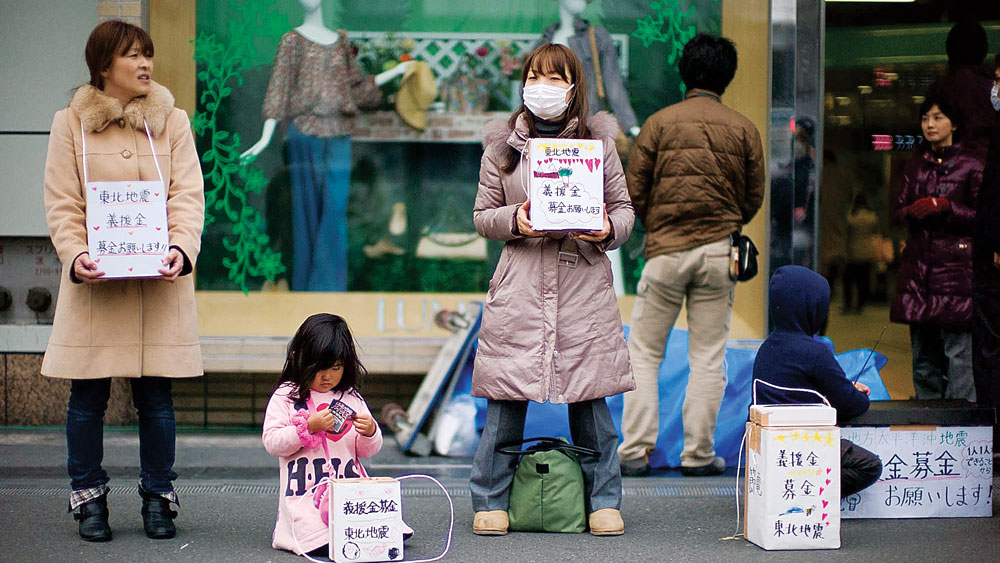Kate Hudson
Production manager
Devastated by an earthquake a thousand times stronger than the 2010 quake that flattened Haiti Japan is struggling to return to normal operations as rescuers uncover thousands of bodies buried in the muddy rubble and, at the same time, racing to avert an imminent nuclear disaster.
But unlike Haiti, Japan is no desolate war zone. Rows upon rows of suburban houses, highways and shopping malls busier than our own have been swept away in a matter of seconds. Over 500,000 people were left without homes.
Among them are university students not unlike ourselves.

Naoyo Yamamoto, an arts student at Doshisha University in Kyoto, shared his story with Excalibur via a Skype interview.
Yamamoto said that although Japanese university students are currently on spring break, the disaster has become a topic of daily conversation.
“People are talking about it everywhere,” he said. “When we return to school, I’m sure a lot of our students will have lost friends. We have to show support. There is a sense of uncertainty, especially about the nuclear situation. We’re not sure what will happen.”
Even as he spoke about death and destruction in his own country, there was a surprising sense of calm and solemnity in Yamamoto’s voice; it is a feeling that reflects the Japanese response as a whole.
Excalibur asked Yamamoto whether he had seen any evidence of looting, stealing or panic on Japanese media coverage.
“No,” he replied. “None at all. People wouldn’t do that here.”
Japan has been hit hard by many natural and man-made disasters in the past century and as a result, developed a strong collective public strategy in its place. Yamamoto explained that most citizens – including students – are familiar with this strategy.
“Since 2007, the government has set up a system that takes over the entire television network to warn people when an earthquake is coming. They always come in pairs,” he recalled. “The first one is much smaller than the second.”
When asked about how much time people had to take cover, he replied “Only seconds. But it’s enough time to get under a desk.”

Japan’s unique cultural unity as an isolated island nation may be part of the reason Japanese people were more emotionally prepared to counter the disaster.
Even then, the tragedy has brought about trying times. For York’s Japanese-Canadian community, it was hard to accept the reality at first.
“When I first saw the news, I thought it was CGI. It looked like one of those scary end-of-the-world movies,” said Mari Kusanagi, a Japanese-Canadian student at York University. “I still can’t believe it. Every morning I wake up and I think, What a horrible dream. But then I look at the news, the newspaper, and I see it’s actually happened.”
Although her parents live in Canada, almost all of Mari’s other family members live in Sendai, one of the major cities struck by the heart of the earthquake and tsunami’s path of destruction. When I spoke to Mari, she had only managed to contact one of those family members.
“My cousin works at the Sendai airport,” she said, her throat tensing. “The entire airport was drowned – covered in water – so I was worried. People ask me, ‘Is your family ok?’ And I almost cry, because I don’t know.”
As of Tuesday, the death toll in the Miyagi region where Sendai is located is estimated at over 10,000. More than 500,000 people have since been displaced from their homes.
“I really don’t know if my house [in Sendai] is still there,” she said. “I might have no place to go back to.”
In Vari Hall, several members of the Japanese International Students’ Association (JISA) folded colourful paper cranes and accepted donations from passersby.
Ken Wu, president of JISA, said he believed fundraising efforts would have to be taken on by individual student efforts, not through official university channels.
“The university should continue to support individual students and student efforts,” said Wu. “But financial donations are a touchy issue. Bringing geopolitics into the situation could cause problems.”
Mari was touched that students are offering support, but the reality for many Japanese who are overseas is that not much can be done besides waiting by the phone for loved ones to call.
“You can’t really do anything – that’s a very Japanese way of thinking,” said Mari. “There’s a word we use called shouganai. That means ‘It’s helpless – you can’t do anything – you have to accept that fact.’”
She checked her phone one more time.
“It was hard before, but that’s how I’m kind of dealing with it now.”
Shouganai: nothing can be done


